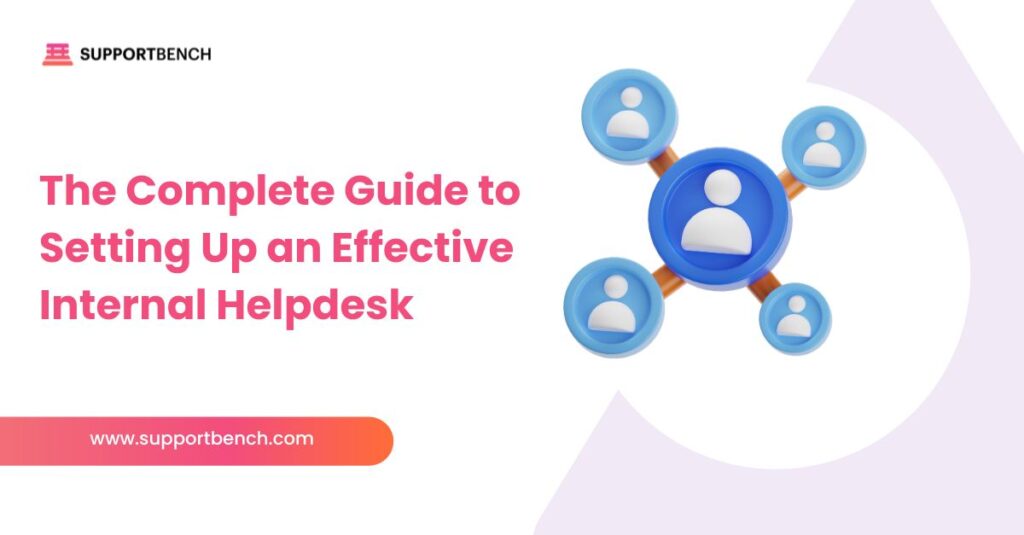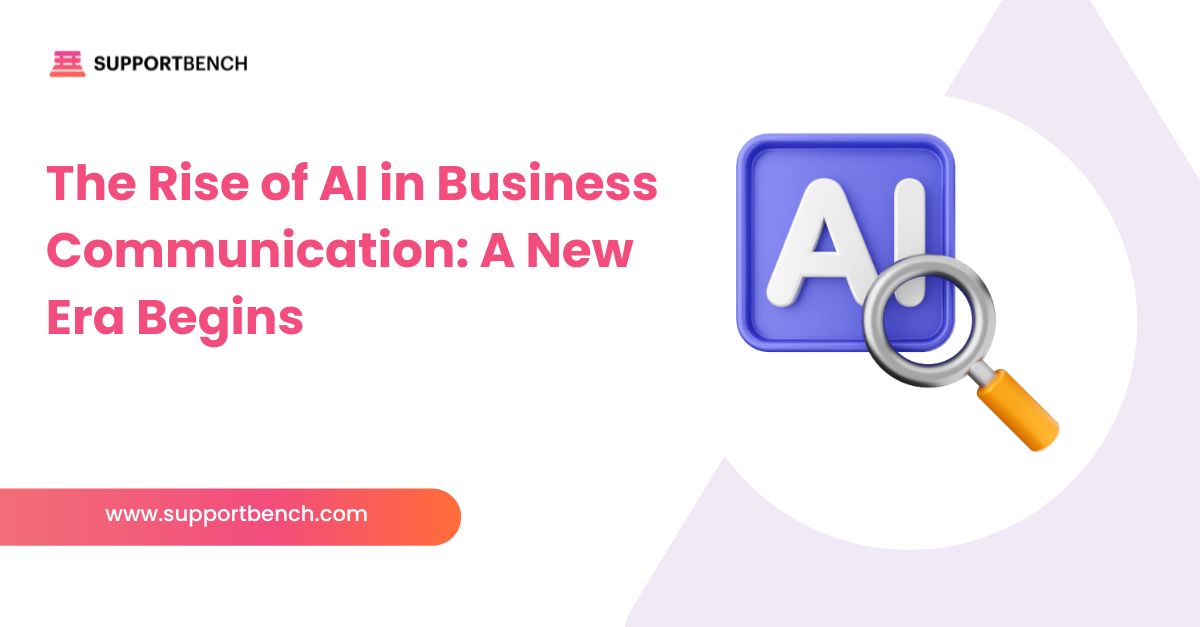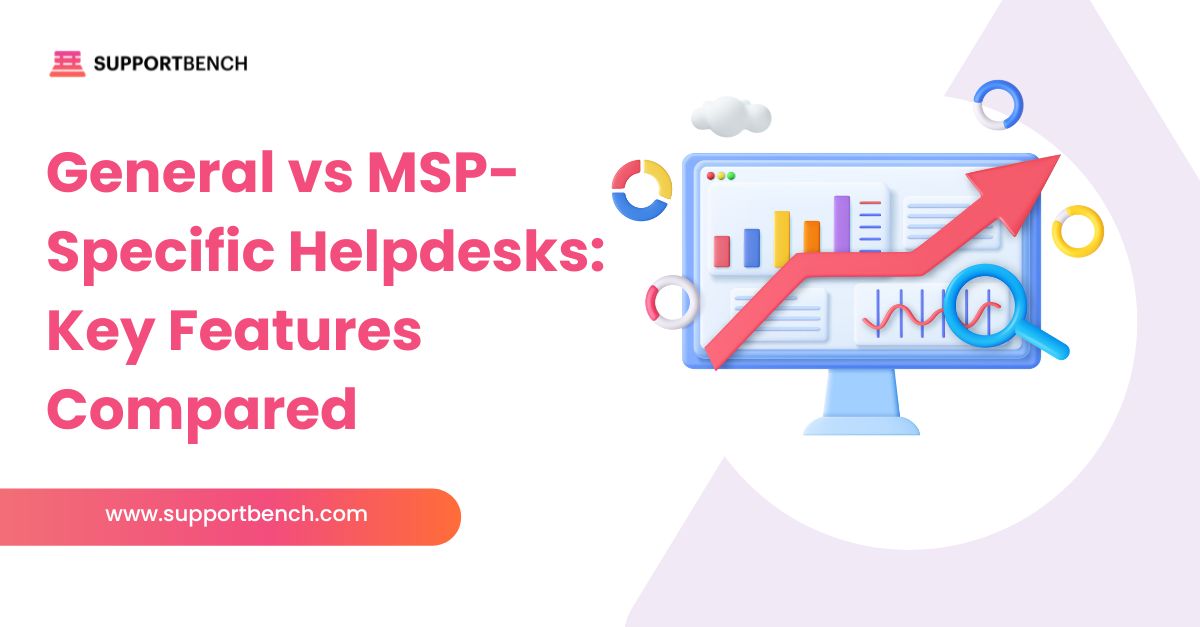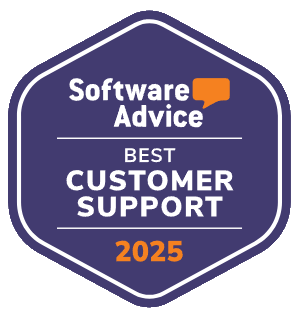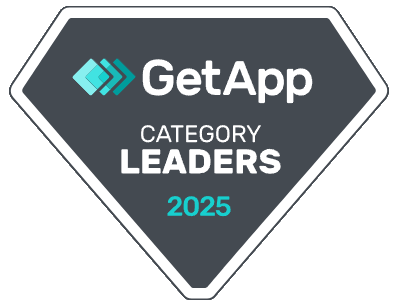An internal helpdesk is more than a system for logging requests—it’s the operational backbone that keeps your team supported and your business running smoothly.
When structured correctly, it empowers employees with efficient processes, fast resolutions, and reliable access to the tools and information they need.
But effective helpdesks aren’t just about installing software. They require clear goals, smart workflows, team accountability, and automation that lightens the load.
From ticket categorisation and knowledge sharing to performance tracking and response templates, every component helps reduce friction and boost service quality.
This guide walks you through a practical, step-by-step approach to building an internal helpdesk that scales with your business and keeps your team productive.

Here is the Quick Answer:
An internal helpdesk improves team productivity by organizing support requests, reducing downtime, and making issue resolution more consistent. To set one up effectively, define clear goals, assign ownership, and choose a reliable platform. Use automation for routine tasks, maintain a strong knowledge base, and track key performance metrics. Regular reviews, good documentation, and agent training keep the system efficient as the business grows.
1. Define Clear Objectives and Governance
Before setting up your internal helpdesk, define what success looks like. Clear goals and role assignments are the foundation of effective, accountable support.
Set Measurable Goals
Decide what “effective” means for your business. Do you want to reduce average resolution time? Improve first-contact resolution? Boost internal satisfaction scores (ESAT)?
Tie each goal to a broader business outcome—such as reducing downtime, maintaining system availability, or limiting escalations.
Assign Roles and Ownership
Everyone on the team should know their responsibilities. Assign specific roles such as triage lead, escalation manager, knowledge base owner, and reporting analyst.
This structure makes the helpdesk easier to manage and guarantees transparency across the team.
2. Select the Right Platform
Spreadsheets and email threads might work in a pinch—but they don’t scale. A purpose-built helpdesk platform brings order, speed, and consistency to internal support.
What to Look For:
✔ Ticket Categorization and Tagging – Helps with smart routing and clear analytics.
✔ SLA Tracking – Keeps your team accountable to response and resolution timelines.
✔ Integrated Knowledge Base – Allows agents to access internal guides and documentation with one click.
✔ Real-Time Dashboards – Provide insights into workload, bottlenecks, and trends.
Why It Matters:
Using a dedicated platform like Supportbench means all of these features work together out of the box. You’ll have SLA monitoring, ticket management, AI summaries, and a centralized knowledge base—all in one easy-to-use system.
3. Define Ticket Categories and Workflows
Organizing incoming tickets into clear categories helps prioritize the most urgent issues and route them to the right people—fast.
Start by creating core categories:
- Password Resets and Login Issues
- Device and Hardware Support
- Business App Troubleshooting
- Network and Connectivity Problems
- Software Installation Requests
Then, build workflows for each category:
- Assign a handling team or individual (e.g., IT or security).
- Define SLAs and expected resolution times.
- Set up routing rules to auto-assign based on keywords or tags.
- Add escalation triggers if no response occurs within set timeframes.
Example: A password reset request might auto-route to the identity access team with a one-hour SLA. If unresolved, it escalates to a team lead. For a network issue, after two hours of inactivity, it could trigger an alert to Level 2 infrastructure support.
This structure ensures tickets flow efficiently and high-impact problems are never overlooked.
4. Build and Maintain a Knowledge Base
A strong internal knowledge base is essential for fast, consistent answers—without needing to raise a ticket. It cuts down repetitive questions, improves first-contact resolution, and empowers employees to solve routine issues on their own.
Must-haves for an effective knowledge base include:
✔ Topic Coverage: Start with your most common ticket categories—like login issues, printer setup, or VPN errors.
✔ Clear Formatting: Use a standard format:
- Issue title
- Problem description
- Environment or system context
- Step-by-step resolution
- Expected result
- Visuals (e.g., screenshots or short videos)
✔ Linked Feedback: Allow internal comments and link articles to resolved tickets for ongoing refinement.
✔ Update Schedule: Assign a knowledge owner and set bi-weekly or monthly review cycles to ensure information stays accurate and relevant.
Tip: Use helpdesk analytics to track which tickets are most frequent and what issues cause delays. These insights can guide new article topics and reveal content gaps.
A well-maintained knowledge base not only saves your team time but also creates a shared, searchable memory for the entire organization.

5. Automate Where It Matters
Strategic automation reduces workload and accelerates resolution without sacrificing service quality. When implemented correctly, it lets support teams focus on higher-value tasks.
High-impact automations to prioritize include:
✔ Automatic Ticket Assignment: Use tags, issue types, or requester profiles to assign tickets to the appropriate team or agent.
✔ Priority-Based Queues: Automate prioritization using SLA policies or ticket keywords so urgent issues rise to the top.
✔ Auto-Responses: Set up instant replies for common issues like password resets, access requests, or known outages.
✔ AI-Powered Summaries: Automatically generate ticket summaries when a case changes status or is reassigned.
✔ Knowledge Article Suggestions: Use resolved tickets to auto-create or recommend new articles for your internal knowledge base.
✔ Sentiment Prediction: Leverage AI to gauge user sentiment early, helping agents prioritize emotionally sensitive cases.
Best Practice: Start with automation for the most repetitive requests. Then expand to include queue routing, status updates, and proactive alerts—always testing to ensure it improves both efficiency and user experience.
6. Prepare Your Team for Success
Even with the best software and automation in place, your internal helpdesk’s effectiveness ultimately depends on people. Well-prepared support agents are essential to consistent, high-quality service.
Here are core training areas to cover:
✔ Ticket Handling Workflows: Teach agents how to use routing rules, apply SLAs, and use macros or templates efficiently.
✔ Communication Skills: Set standards for tone, clarity, and empathy in internal responses. A polite, direct style reduces back-and-forth.
✔ Knowledge Base Usage: Show agents how to search for solutions and contribute new or updated content regularly.
✔ Using Dashboards and Reports: Help agents track their own metrics and identify trends that can inform improvements.
Tactics to reinforce learning include:
✔ Run role-play simulations of ticket scenarios.
✔ Pair new hires with experienced agents for shadowing.
✔ Share weekly “tip of the week” highlights in team channels.
✔ Offer quick refreshers when new tools or processes are introduced.
Best Practice: Treat training as ongoing, not one-time. Regular knowledge-sharing and reinforcement sessions keep skills sharp and maintain alignment as systems and expectations evolve.
7. Report with Insight
Data is only valuable if it drives decisions. Effective reporting transforms raw metrics into actionable insights that help your internal helpdesk evolve and deliver better results.
Key Performance Indicators (KPIs) to Track:
|
Metric |
Why It Matters |
|
First Contact Resolution |
Reflects triage effectiveness and reduces repeat tickets. |
| Mean Time to Resolution |
Measures how efficiently the helpdesk handles requests. |
|
Ticket Volume by Category |
Highlights trends, recurring issues, and documentation gaps. |
| SLA Compliance Rates |
Ensures internal service agreements are consistently met. |
|
Agent Utilization |
Balances workloads and prevents burnout. |
| Employee Satisfaction (ESAT) |
Captures user perception and identifies morale or service gaps. |
Best Practice: Use dashboards that make performance visible at a glance. Automate weekly summary reports for team leads and provide deeper monthly insights to leadership. Look for patterns—not just averages—to inform staffing, documentation, and workflow adjustments.
8. Review and Iterate
An internal helpdesk isn’t a “set it and forget it” tool—it needs regular attention to stay efficient, aligned, and scalable. A proactive review cycle helps resolve recurring issues, refine workflows, and adapt to evolving organizational needs.
Monthly Review Cycle:
✔ Analyze Ticket Trends: Look for repeat issues, seasonal spikes, or workflow bottlenecks. Identify which requests could be deflected through automation or documentation.
✔ Update the Knowledge Base: Audit articles for accuracy, relevance, and clarity. Add missing content for frequent tickets and retire outdated ones.
✔ Gather Feedback: Encourage both agents and users to report friction points. Use surveys or short retros to capture insights and surface opportunities for improvement.

Quarterly Refinements:
✔ Adjust Workflows and Categories: Streamline categories that are too broad or confusing. Refine escalation rules and reassess lead times.
✔ Revisit SLAs: As ticket types or volumes change, align your service-level targets accordingly.
✔ Deliver Refresher Training: Offer short sessions to reinforce new tools, processes, or trends. Keep learning continuous and relevant.
Best Practice: Treat each review as a system health check. Use the data gathered to reduce workload, resolve issues faster, and improve internal customer experience.
9. Align With Wider IT and Business Functions
An internal helpdesk performs at its best when it’s not isolated. Integration with the wider IT ecosystem and business departments ensures smoother workflows and faster resolutions.
Break Down Silos
Helpdesk operations shouldn’t function in a vacuum. Integrate with teams like HR, infrastructure, security, and facilities to streamline requests and escalations.
Key integration touchpoints include:
- System Monitoring Tools: Automatically create tickets when alerts fire—e.g., “Disk usage exceeded threshold” or “Server offline.”
- HR Systems: Sync for onboarding and offboarding tasks, such as setting up new employee accounts or revoking access rights.
- Facilities and Admin Teams: Route non-IT requests (like office equipment or building access) to appropriate teams without manual reassignment.
- Planning and Analytics Teams: Share ticket data to uncover recurring problems that may point to deeper process or product gaps.
Example: If Wi-Fi outages spike across multiple floors, the helpdesk system should automatically escalate to the infrastructure team, log the timeline, and close the loop once resolved—all while keeping internal users informed.
Benefits of Broader Alignment
✔ Reduces duplicate work and finger-pointing
✔ Speeds up response times by routing tickets accurately
✔ Creates a more cohesive experience for employees
✔ Supports data-driven investment decisions across departments
By aligning the helpdesk with IT and business functions, you create an intelligent support hub that’s more than reactive—it’s strategic.

10. Build a Culture of Support and Ownership
A high-functioning internal helpdesk is more than a ticket-processing engine—it’s a collaborative service that reflects your company culture. Building a sense of ownership among agents fosters accountability, while recognition and feedback strengthen team morale.
Recognize Positive Contributions
Shout-outs and recognition go a long way. Highlight agents who go the extra mile, contribute valuable documentation, or help colleagues solve tough problems. Use team meetings or internal dashboards to celebrate these moments and reinforce best practices.
Create Feedback Loops
Encourage team members to share process improvement ideas. Make it clear that their suggestions are valued—then act on them. When agents see their input lead to changes, it reinforces their role as collaborators, not just responders.
Promote Shared Responsibility
Support isn’t a one-person job. From triage leads to knowledge base managers, each role contributes to a smoother operation. When everyone understands their responsibility and impact, ownership becomes second nature.
➤ A culture of shared accountability leads to better collaboration, higher satisfaction, and stronger support outcomes—for both agents and end-users.
11. Scale with Confidence
As your organization grows, your internal helpdesk must evolve to handle increasing complexity without adding friction. A scalable system allows you to maintain high service quality while supporting more users, tools, and requests.
Expand with Structure
Start by implementing logical tiers (Level 0–3) to manage different levels of issue complexity. This makes sure basic inquiries don’t slow down advanced support. Use round-robin or skill-based routing to balance workloads and connect issues to the most qualified agents.
Support Specialized Use Cases
As your company diversifies, segment tickets by business unit or category—such as IT, Facilities, HR, or Procurement. Tailor SLAs and workflows for each to reflect their specific service expectations.
Add Flexibility with Language and Regional Support
If your workforce is distributed, implement multilingual support and region-specific SLAs. This improves accessibility and aligns with local compliance and response standards.
Leverage a Scalable Platform
Supportbench offers role-based controls, customizable ticket forms, and flexible agent licensing, making it easier to grow your support operations without disruption.
➤ The key to scaling successfully isn’t more tools—it’s smarter structure and a platform designed for controlled, sustainable growth.
12. Measure Business Impact
Operational efficiency is essential, but to justify investment and earn internal support, your helpdesk must show clear business value. Go beyond ticket metrics to demonstrate how support contributes to broader organizational goals.
Link Helpdesk to Business Outcomes
Establish key performance indicators (KPIs) that connect support activity with business impact:
|
KPI |
Business Value |
| Reduced Employee Downtime |
Fewer delays caused by unresolved IT or access issues |
|
Uptime of Key Tools |
Helps maintain productivity and system reliability |
| Cost Savings from Ticket Deflection |
Self-service reduces ticket volume and agent workload |
|
Faster Onboarding |
New hires get access and training quickly, minimizing ramp-up time |
| Lower Turnover |
Fast, effective support increases employee satisfaction and retention |
Present Meaningful Metrics to Leadership
Use dashboards to surface trends and flag inefficiencies, but tailor monthly or quarterly reports to highlight outcomes executives care about—such as productivity gains, cost savings, or risk reduction.
Tell the Full Story
Combine support data with feedback from employee surveys, system uptime records, or productivity tools to illustrate the broader impact. For example, if quicker issue resolution cut onboarding time by 30%, link that to cost savings and better employee engagement.
➤ When your helpdesk improves performance, saves time, and supports business growth—it’s not just a service function, it’s a strategic asset.

13. Reduce Ticket Resolution Time
Fast resolution is one of the clearest signs of a well-functioning internal helpdesk. The quicker issues are resolved, the less disruption employees experience, and the more productive the entire organization becomes.
Shorter ticket resolution times lead to:
- Fewer support bottlenecks
- Higher employee satisfaction
- Greater confidence in IT responsiveness
✔ Automate Routine Tasks: Set up automation for common issues like password resets, access requests, and printer setup to reduce manual handling.
✔ Categorize Tickets Clearly: Clear categories allow smart routing, ensuring the right person addresses the issue on the first try.
✔ Use Knowledge Base Articles: Encourage agents to share relevant help articles with users to deflect repeated questions and reduce handling time.
✔ Track and Review Resolution Times: Regularly monitor mean time to resolution (MTTR) to identify patterns and flag workflow bottlenecks.
✔ Use Response Templates: Create response templates for common inquiries. These save time and maintain consistency in tone and clarity across agents.
Even incremental improvements in resolution time can dramatically improve team capacity and reduce operational drag. Make resolution speed a priority metric and align training, automation, and workflows to support it.
Challenges and How to Handle Them
Even the most well-structured helpdesks encounter challenges that can impact service quality and team morale. Anticipating these issues—and addressing them proactively—keeps internal support resilient and responsive.
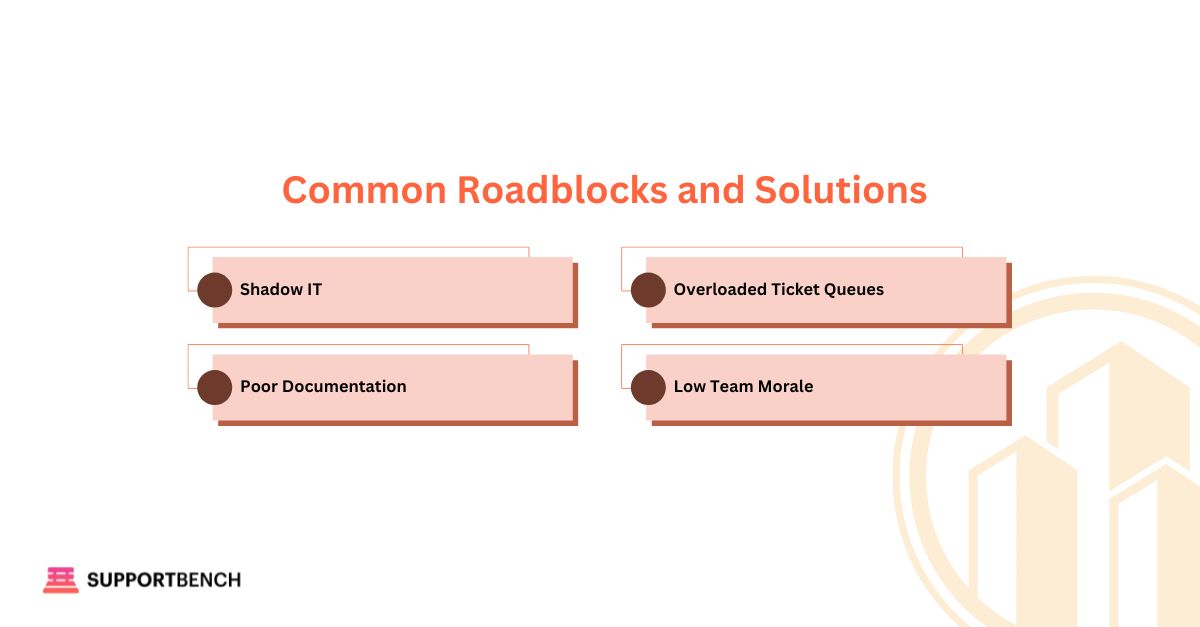
Shadow IT
Employees using unauthorized software or tools create support blind spots and potential security risks.
Solution: Educate staff on approved tools, explain risks of unsupported software, and offer secure alternatives that meet their needs.
Overloaded Ticket Queues
A backlog of unresolved tickets leads to missed SLAs, stressed agents, and frustrated end users.
Solution: Automate triage, implement self-service options for common requests, and review workflows regularly to ease bottlenecks.
Poor Documentation
Incomplete or outdated internal articles slow resolution and increase agent reliance on tribal knowledge.
Solution: Schedule regular content reviews, track usage metrics, and assign ownership for documentation maintenance.
Low Team Morale
Monotony, underappreciation, and a lack of career development can wear down team energy and motivation.
Solution: Recognize achievements, encourage learning, rotate duties, and create opportunities for team input on process improvements.
➤ By addressing these root causes head-on, organizations reduce internal friction, support team well-being, and preserve service quality—even as needs evolve.
SupportBench: How the Platform Helps
SupportBench empowers internal support teams by unifying ticketing, knowledge management, automation, and analytics into one purpose-built platform.
From setup to scaling, SupportBench is designed to remove complexity and boost performance.
Here are key capabilities that make a difference:
✅ Smart Ticketing and Workflow Automation: Route tickets automatically based on categories, SLAs, or user groups. Built-in AI can generate case summaries and suggest next steps—saving agents time and improving accuracy.
✅ Integrated Knowledge Base: SupportBench makes it easy to turn solved tickets into articles. With built-in editing tools, ownership controls, and smart article suggestions, teams can reduce repetitive tickets and support self-service.
✅ Real-Time Dashboards and SLA Tracking: Customizable dashboards give leads and executives instant visibility into ticket volumes, SLA compliance, team utilization, and performance trends.
✅ Multichannel and Internal Communication: Whether your team works through email, chat, or internal portals, SupportBench ensures every conversation is logged and visible. The platform also integrates seamlessly with HR platforms, collaboration tools, and asset systems to streamline internal workflows.
✅ Scalable, No-Code Configuration: Add users, update workflows, and adjust permission settings without developer support. With no-code configuration, the platform grows as your business does—without introducing overhead.
✅ Built-In Feedback and Continuous Improvement Tools: CSAT tracking, predictive sentiment scoring, and feedback loops are built in—helping you measure employee satisfaction and identify opportunities for training or process improvement.
SupportBench gives internal helpdesks the visibility, automation, and clarity needed to deliver fast, consistent, and high-quality support—without sacrificing flexibility or ease of use.
Conclusion
A well-structured internal helpdesk delivers more than just ticket resolution—it drives productivity, builds confidence, and strengthens internal collaboration. When employees know they can count on fast, clear, and effective support, the entire organization runs more smoothly.
Success starts with clear goals, a purpose-built platform, and workflows that make sense for your team. Add automation, a searchable knowledge base, and reporting tools, and your helpdesk becomes a proactive support hub rather than a reactive cost centre.
The right platform makes this transformation possible. Supportbench brings everything together—ticketing, self-service, SLA tracking, automation, and analytics—so you can scale support without increasing complexity.
Whether you’re building your helpdesk from scratch or improving an existing one, Supportbench provides the tools and structure to do it right.
Book a demo today and see how Supportbench can help your internal team work smarter, resolve faster, and support your organization with confidence.


